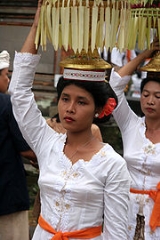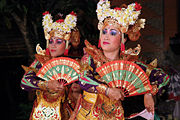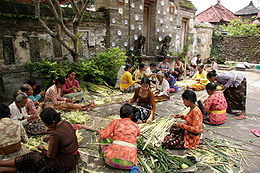
Balinese people
Encyclopedia
The Balinese population of 3.0 million (1.5% of Indonesia
's population) live mostly on the island of Bali
, making up 89% of the island's population. There are also significant populations on the island of Lombok
, and in the eastern-most regions of Java (e.g. the Municipality of Banyuwangi
).
It is the most populous Hindu majority island in the world
in the prehistoric times of the proto-Malay stock; the second wave of Balinese came slowly over the years from Java during the Hindu
period; the third and final period came from Java, between the 15th and 16th centuries, at the time of the conversion of Islam
in Java, aristocrats fled to Bali
from the Javanese Majapahit Empire
to escape Islamic conversion, reshaping the Balinese culture into a syncretic
form of classical Javanese culture with many Balinese elements.
 Balinese culture is perhaps most known for its dance, drama and sculpture. The culture is noted for its use of the gamelan
Balinese culture is perhaps most known for its dance, drama and sculpture. The culture is noted for its use of the gamelan
in music. The island is also known for its form of Wayang kulit or Shadow play
/Shadow Puppet theatre. It also has several unique aspects related to their religions traditions. Balinese culture is a mix of Balinese Hindu/Buddhist religion and Balinese custom.
Traditionally, a display of female breasts is free not regarded as immodest, Balinese women in the last century can often be seen with their bare chest, instead a display of the thigh is immodest. In modern Bali these ethics are normally not followed anymore, but visitors visiting Balinese temples they are advised to cover their legs.
In the Balinese naming system
, a person's rank of birth or caste is reflected in the name.
is an act of mass suicide, and was first noted by the Dutch during the colonization of Bali. The latest act of puputan was during the Indonesian war of Independence, with I Gusti Ngurah Rai
as the leader. The airport in Bali is named after him in commemoration.
ite sect of Hinduism
. Traveling Indian priests are said to have introduced the people to the sacred literature of Hinduism and Buddhism centuries ago. The people accepted it and combined it with their own pre-Hindu mythologies
. The Balinese from before the third wave of immigration, known as the Bali Aga
, are mostly not followers of Agama Tirta, but retain their own animist traditions.
 Kuta Karnaval, Sanur Beach Festival.
Kuta Karnaval, Sanur Beach Festival.
Indonesia
Indonesia , officially the Republic of Indonesia , is a country in Southeast Asia and Oceania. Indonesia is an archipelago comprising approximately 13,000 islands. It has 33 provinces with over 238 million people, and is the world's fourth most populous country. Indonesia is a republic, with an...
's population) live mostly on the island of Bali
Bali
Bali is an Indonesian island located in the westernmost end of the Lesser Sunda Islands, lying between Java to the west and Lombok to the east...
, making up 89% of the island's population. There are also significant populations on the island of Lombok
Lombok
Lombok is an island in West Nusa Tenggara province, Indonesia. It forms part of the chain of the Lesser Sunda Islands, with the Lombok Strait separating it from Bali to the west and the Alas Strait between it and Sumbawa to the east...
, and in the eastern-most regions of Java (e.g. the Municipality of Banyuwangi
Banyuwangi
The Regency of Banyuwangi is located at the easternmost end of the Indonesian island of Java and it is a very strategic area for those who want to go to Bali, since it also serves as an important ferry port between Java and Bali. It is surrounded by mountains and forests to the west; by sea to the...
).
It is the most populous Hindu majority island in the world
Origins
The origins of the Balinese came from three periods: The first waves of immigrants came from Java and KalimantanKalimantan
In English, the term Kalimantan refers to the Indonesian portion of the island of Borneo, while in Indonesian, the term "Kalimantan" refers to the whole island of Borneo....
in the prehistoric times of the proto-Malay stock; the second wave of Balinese came slowly over the years from Java during the Hindu
Hindu
Hindu refers to an identity associated with the philosophical, religious and cultural systems that are indigenous to the Indian subcontinent. As used in the Constitution of India, the word "Hindu" is also attributed to all persons professing any Indian religion...
period; the third and final period came from Java, between the 15th and 16th centuries, at the time of the conversion of Islam
Islam
Islam . The most common are and . : Arabic pronunciation varies regionally. The first vowel ranges from ~~. The second vowel ranges from ~~~...
in Java, aristocrats fled to Bali
Bali
Bali is an Indonesian island located in the westernmost end of the Lesser Sunda Islands, lying between Java to the west and Lombok to the east...
from the Javanese Majapahit Empire
Majapahit Empire
Majapahit was a vast archipelagic empire based on the island of Java from 1293 to around 1500. Majapahit reached its peak of glory during the era of Hayam Wuruk, whose reign from 1350 to 1389 marked by conquest which extended through Southeast Asia. His achievement is also credited to his prime...
to escape Islamic conversion, reshaping the Balinese culture into a syncretic
Syncretism
Syncretism is the combining of different beliefs, often while melding practices of various schools of thought. The term means "combining", but see below for the origin of the word...
form of classical Javanese culture with many Balinese elements.
Culture

Gamelan
A gamelan is a musical ensemble from Indonesia, typically from the islands of Bali or Java, featuring a variety of instruments such as metallophones, xylophones, drums and gongs; bamboo flutes, bowed and plucked strings. Vocalists may also be included....
in music. The island is also known for its form of Wayang kulit or Shadow play
Shadow play
Shadow play or shadow puppetry Shadow puppets have a long history in China, India, Turkey and Java, and as a popular form of entertainment for both children and adults in many countries around the world. A shadow puppet is a cut-out figure held between a source of light and a translucent screen...
/Shadow Puppet theatre. It also has several unique aspects related to their religions traditions. Balinese culture is a mix of Balinese Hindu/Buddhist religion and Balinese custom.
Traditionally, a display of female breasts is free not regarded as immodest, Balinese women in the last century can often be seen with their bare chest, instead a display of the thigh is immodest. In modern Bali these ethics are normally not followed anymore, but visitors visiting Balinese temples they are advised to cover their legs.
In the Balinese naming system
Balinese name
The Balinese name is a naming system used by the Balinese people of Bali, Indonesia and the Western parts of neighboring Lombok, Indonesia. Since most Balinese are Hindus, most names are Hindi or Sanskrit, while others still use native Balinese one. Regardless of being male or female, each person...
, a person's rank of birth or caste is reflected in the name.
Puputan
A PuputanPuputan
Puputan is a Balinese term that refers to a mass ritual suicide in preference to facing the humiliation of surrender. Notable puputans occurred in 1906 and 1908 when the Balinese were being subjugated by the Dutch.- 1906 Badung puputan :...
is an act of mass suicide, and was first noted by the Dutch during the colonization of Bali. The latest act of puputan was during the Indonesian war of Independence, with I Gusti Ngurah Rai
I Gusti Ngurah Rai
Lieutenant Colonel I Gusti Ngurah Rai is an Indonesian National Hero who commanded Indonesian forces in Bali against the Dutch during the Indonesian War of Independence...
as the leader. The airport in Bali is named after him in commemoration.
Religion
The vast majority of the Balinese believe in Agama Tirta, "holy-water religion". It is a ShivaShiva
Shiva is a major Hindu deity, and is the destroyer god or transformer among the Trimurti, the Hindu Trinity of the primary aspects of the divine. God Shiva is a yogi who has notice of everything that happens in the world and is the main aspect of life. Yet one with great power lives a life of a...
ite sect of Hinduism
Hinduism
Hinduism is the predominant and indigenous religious tradition of the Indian Subcontinent. Hinduism is known to its followers as , amongst many other expressions...
. Traveling Indian priests are said to have introduced the people to the sacred literature of Hinduism and Buddhism centuries ago. The people accepted it and combined it with their own pre-Hindu mythologies
Balinese mythology
Balinese mythology is the traditional mythology of the people of the Indonesian island of Bali, before the majority adoption of Hinduism.Balinese mythology is mainly a kind of animism with some widely-known characters and deities...
. The Balinese from before the third wave of immigration, known as the Bali Aga
Bali Aga
The Bali Aga, Baliaga or Bali Mula are the original Balinese people, predominantly located in the eastern part of the island, in Karangasem. They can also be found in north-western and central regions.-Origin:...
, are mostly not followers of Agama Tirta, but retain their own animist traditions.
Festivals

See also
- Kite festivalKite festivalThe Bali Kite Festival is an annual international kite festival held in July in Padang Galak area, Sanur Beach, Bali. Traditional giant kites are made and flown competitively by teams from the villages of Denpasar...
- GalunganGalunganGalungan is a Balinese holiday that occurs every 210 days and lasts for 10 days. Kuningan is the last day of the holiday. Galungan means "When the Dharma is winning." During this holiday the Balinese gods visit the Earth and leave on Kuningan....
- NyepiNyepiNyepi is a Balinese "Day of Silence" that is commemorated every Isakawarsa according to Bali's calendar . It is a day of silence, fasting, and meditation. The day following Nyepi is also celebrated as New year.Observed from 6 a.m. until 6 a.m...
- SaraswatiSaraswatiIn Hinduism Saraswati , is the goddess of knowledge, music, arts, science and technology. She is the consort of Brahma, also revered as His Shakti....
- Pager wesi
- NgabenNgabenNgaben, or Cremation Ceremony, is the ritual performed in Bali to send the deceased to the next life. The body of the deceased will be placed as if sleeping, and the family will continue to treat the deceased as sleeping...
- LegongLegongLegong is a form of Balinese dance. It is a refined dance form characterized by intricate finger movements, complicated footwork, and expressive gestures and facial expressions....
- SanghyangSanghyangSanghyang is a sacred Balinese dance, based on the idea that a force enters the body of an entranced performer. The force, identified as hyang, is important spiritual entities in ancient Indonesian mythology. Sanghyang dedari is a dance performed by pre-pubescent girls, similar in some ways to the...
- KecakKecakKecak is a form of Balinese dance and music drama, originated in the 1930s Bali and is performed primarily by men, although a few women's kecak groups exist as of 2006....

